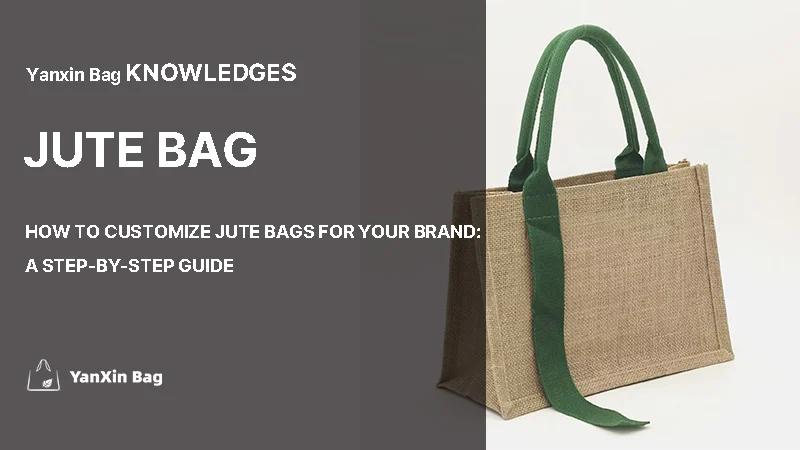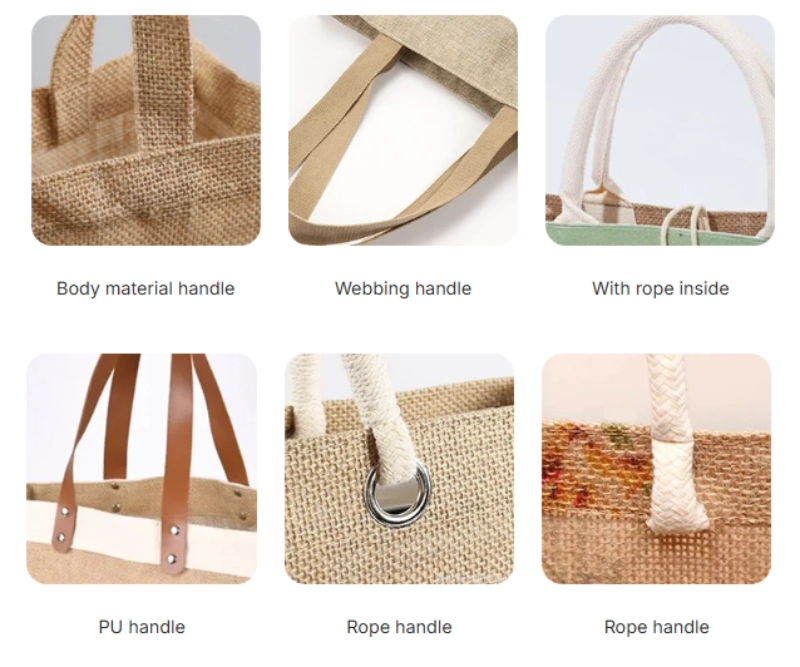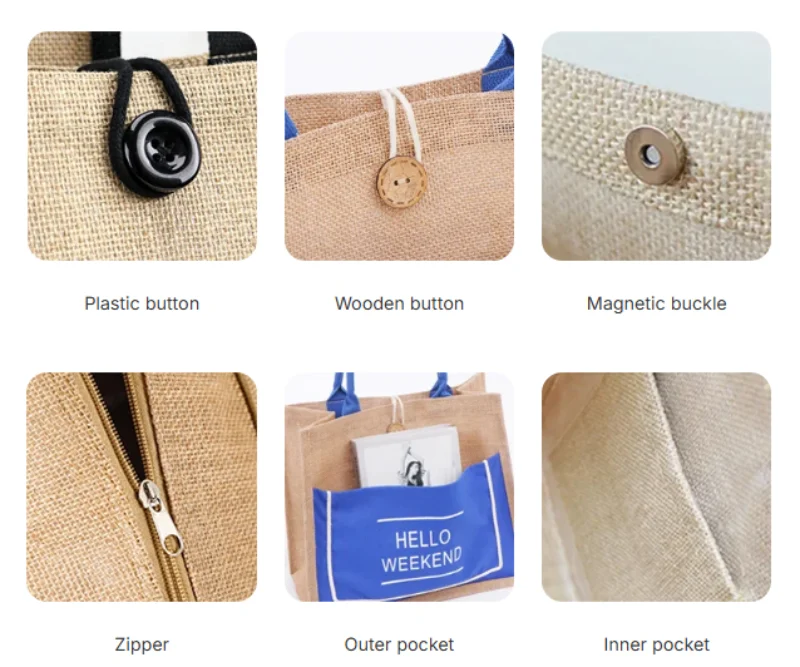Our Academy

Thinking about custom jute bags but not sure where to start? This practical guide walks you through everything—from sizing and printing options to ordering steps and key considerations.
How to Customize Jute Bags for Your Brand? Customizing jute tote bags (also known as hessian or burlap bags) begins with choosing the right size, fabric weight, and handle type. Then, plan your logo placement and select a printing method—screen printing and UV printing are the most commonly used for bulk orders. If your design includes photo-realistic images or gradient colors, heat transfer printing is another option to consider. Before finalizing, make sure to confirm your order quantity, delivery timeline, and packaging preferences. A thoughtfully customized eco bag can be a powerful and sustainable branding tool.
Once you have a general idea of the process, the next step is to break down the key customization options—like bag dimensions, handle styles, material thickness, and printing techniques—so you can make confident decisions at every stage.
Customizing jute bags isn’t complicated—as long as you know which parts can be tailored to your needs. Whether this is your first order or you already have a basic idea, the following options will shape your bag’s final look, function, and brand impact. In this guide, we’ll break down each customizable element and offer tips to help you make informed choices quickly.
Jute bag sizes are fully customizable, but bigger doesn’t always mean better. The ideal size depends on your product and usage scenario. Before choosing dimensions, consider the following:
What will the bag hold? (Brochures, gifts, food, samples, bottles, etc.)
Will customers carry it for long periods? Do you need better portability or load capacity?
Do you have a budget constraint? Larger bags often cost more.
While any size can be made to order, here are three of the most commonly requested sizes to guide your decision:
Small (S): 26.5W × 20H × 9G cm
Great for samples, small gifts, or lightweight promotional materials.
Medium (M): 36.5W × 30H × 17G cm
Ideal for everyday shopping, trade show giveaways, or retail branding. This is the most popular size.
Large (L): 45W × 35H × 14G cm
Suitable for books, bottle gift sets, or bulkier items. Offers a more impactful visual presence.

If you’re unsure which size to choose, simply share your intended use and a reference item or sketch. Your supplier can usually recommend the best dimensions and help you avoid bags that are too large or too small.
Coated Jute Bags: These bags have a layer of PE film on the inside, giving them better water resistance and structural stiffness. Even when empty, they can stand upright on their own. This makes them ideal for structured shopping bags, trade show giveaways, or promotional gift bags. The coating also helps ensure stable and sharp printing results, making this the most common choice for commercial customization.
Uncoated Jute Bags: Made from raw natural jute fiber, these bags feel softer and retain more of the material’s breathable, rustic texture. They’re often used for drawstring pouches, small gift bags, or any project that calls for a more relaxed or minimal aesthetic. However, they are less water-resistant, so they’re not recommended for damp environments.

The most commonly used jute fabrics for tote bags are 45D and 50D. Both offer decent stiffness and support, but there are slight differences in texture and finish:
45D: Slightly softer and more budget-friendly. Ideal for everyday promotional bags, sample giveaways, or bulk orders where cost efficiency matters.
50D: Tighter weave and slightly thicker feel. Offers a cleaner print result and richer color saturation, making it better suited for higher-end branding or complex designs. We often recommend 50D for clients who prioritize visual impact.
If you’re not sure which one to choose, consider how the bag will be used—whether it’s for official promotions, trade shows, or simple giveaways—and how complex your printing will be. Your supplier can help you match the right fabric to your needs.
Jute is a biodegradable material. True
Jute is a natural fiber that is biodegradable, making it an environmentally friendly option.
Jute is naturally resistant to UV radiation. False
Jute is not naturally resistant to UV radiation but can be treated with chemicals to improve UV stability.
Jute Handles
Made from the same fabric as the bag body, these handles offer a natural, unified look. The material is relatively stiff, retaining the rough texture of raw jute fibers.
Cotton Rope Handles
These are twisted cotton cords with a soft grip and strong woven texture. Most come in natural white or raw cotton tones, but custom-dyed options are available.
Webbing Handles
Featuring a flat and sturdy structure, webbing handles are highly durable and available in a wide range of colors. Both the width and length can be customized based on your needs.
Webbing with Cotton Core
These handles are reinforced with a cotton core wrapped inside the webbing, offering a thicker and more comfortable grip. The outer look remains similar to regular webbing.
PU Leather Handles
Smooth on the surface and styled to look like real leather, these handles add a modern, sleek finish—ideal for brands looking for a premium or high-contrast aesthetic.
Eyelet Handles
Attached using metal eyelets, this style enhances structural strength and adds a touch of industrial or decorative flair. The metal hardware and handle material can be color-matched.

If you’re hoping to match the handle color exactly with the jute fabric, keep in mind that different materials (like jute fabric vs. cotton webbing or PU) absorb dyes differently. Even with the same color code, some color variation is inevitable.
For a more seamless look, you can choose to make the handles using the same jute material as the bag, though this tends to be stiffer. On the other hand, many brands prefer a contrasting color design, such as pairing a natural jute bag with deep navy or burgundy handles—creating a bold, stylish contrast that enhances brand visibility.
Printing plays a key role in how your custom jute bags look and how well your brand is represented. Each type of artwork works best with a specific printing technique. Understanding the differences can help you make the right decision before placing an order.
Screen printing is the most widely used method for jute bags. It works by applying ink through a mesh screen onto the fabric, layer by layer. This technique is ideal for simple designs with 1–2 solid colors and sharp edges. It’s reliable, cost-effective for bulk production, and produces crisp, long-lasting prints, making it the go-to choice for most custom jute bag projects.
UV printing sprays the design directly onto the surface of the bag using CMYK ink and instantly cures it with ultraviolet light. It works well for flat-style graphics like logos, icons, or bold illustrations with clean edges and clear color blocks. While it delivers accurate colors and sharp outlines, it’s not suitable for photo-realistic images or complex gradients. The final look is more graphic and modern, making it a great option for small to medium runs.
Heat transfer printing involves printing the artwork onto a film, which is then pressed onto the bag using high heat. This method can achieve photo-level image quality, fine details, and smooth gradients—perfect for portraits, scenery, or any realistic design.
However, since jute is a coarse natural fiber, the bonding between the image layer and the fabric is less stable than with other methods. With repeated use or heavy folding, the design may start to peel or crack. Also, this process is more complex and costly, so it’s generally recommended for small batches or special designs where high visual impact is required.
| Printing Method | Color Accuracy | Design Compatibility | Cost | Print Durability | Summary |
|---|---|---|---|---|---|
| Screen Printing | High (spot colors, minimal deviation) | Simple graphics, logos, text | Low | High | Most stable colors, ideal for large runs |
| UV Printing | Medium (CMYK printing) | Flat-style illustrations, sharp-edged designs | Medium | High | Great for flat designs, clean results |
| Heat Transfer | Medium-High (CMYK printing) | Realistic images, photo-level graphics | High | Lower | Best for detailed or complex designs, high visual appeal |
When customizing jute bags, many customers ask: Where can my design be printed? Can I print full coverage? Are there any color limitations? Below are a few key points to help you plan your design effectively:
Most jute bags are printed on the front panel, but double-sided printing is also available. For full-bleed printing (where the design covers the entire surface or even wraps around the edges), UV printing is recommended. This method is better suited for large-area or edge-to-edge designs.
Although the bag size is fully customizable, designs should not be too large. Artwork placed too close to the edges may be affected by seams or stitching. Oversized prints can also create a visually unbalanced look, especially if the layout feels too cramped.
If you need a larger print area, inform your supplier in advance so they can help confirm the safe print zone based on your bag’s dimensions.
Jute is widely used for making sacks, bags, and textiles. True
Jute is commonly used to make sacks, bags, carpets, and textiles due to its strength and durability.
Jute fabric is always soft and smooth. False
Raw jute is generally coarse and stiff. Its natural texture contributes to its rustic and eco-friendly appearance.
Screen printing supports spot colors and offers very accurate color matching. However, it’s best limited to 1–2 colors to avoid registration issues and additional costs.
UV printing uses CMYK process colors, making it ideal for designs with solid color blocks or clean edges, but it’s not suitable for photorealistic images or soft gradients.
Heat transfer is currently the best option for detailed graphics and gradient effects, including photos, portraits, or illustration-heavy designs. That said, it comes with higher costs, and on coarse jute fabric, the adhesion may not be as durable as with screen or UV printing.
Jute bags can be made in a variety of structural designs—from classic gusseted totes with expanded sides and bottoms, to more complex styles like panel stitching, color-blocking, front pockets, or even wine carriers. We’ve created a separate guide that showcases 10 popular jute bag structures, complete with real photos and descriptions. Explore: Everything You Need to Know about Jute Bags
Depending on your use case, you can also add the following accessories to enhance the bag’s functionality:
Zippers (for top closures that add privacy and security)
Velcro or Snap Buttons (easy-close options often used in promotional bags)
Inner Pockets / Dividers (for organized storage and added practicality)
Outer Pockets (ideal for flyers, business cards, or small items)
Bottom Inserts (to reinforce the base and help the bag stand upright)
The combination of structure and accessories will impact the final look, user experience, and unit cost. Choose features that align with your brand identity and intended use.

Customizing a jute bag goes far beyond just adding a logo. It involves careful decisions around size, fabric type, handle style, printing method, structure, and accessories. Each of these elements plays a key role in how your final bag looks, feels, and represents your brand.
If you already have a clear design in mind, you can move straight to requesting a quote and sample from your supplier. If you’re still exploring your options, start with the key choices we covered in this guide—like popular sizes, handle types, and printing options—to gradually shape your ideal jute bag.
As a professional custom jute bag manufacturer, Yanxin Bag offers in-house production and extensive export experience. From sampling and printing to bulk manufacturing, we provide reliable, efficient, and quality-driven service to help your brand stand out. Contact Yanxin Bag today for a free consultation and pricing—let’s create stylish and sustainable jute bags that elevate your brand impact.
Customizing a jute bag? Start with the full picture.
This article covers everything from what jute bags are to how they’re made, what they’re used for, and how they compare to other types. It’s an essential reference for making informed structural design decisions.
Confused about the difference between jute and burlap?
This article compares the definitions, industrial usage, and naming conventions of jute and burlap, highlighting where misunderstandings may affect your material choices or communication during customization.
Planning large-scale custom orders? Know your bulk benefits.
This article breaks down the key advantages of ordering jute bags in bulk — including price, print consistency, logistics efficiency, and stock control — all of which strengthen the long-term customization process.
Custom shapes need matching print strategies.
This guide explains the considerations needed for jute bag printing — including material limitations, workable surfaces, and matching print methods to structure — ideal for brands aiming for visual and functional harmony.
Not sure which jute bag type fits your custom plan?
The article categorizes common jute bag styles like drawstrings, shoppers, wine carriers, and gift bags, with detailed notes on shape, handles, and space — helping you align customization choices with use cases.
Get a free quote and expert consultation today. Let's bring your brand vision to life.
1Learn about the factors that determine weight capacity to choose bags that meet your carrying needs effectively.
2Discover how these elements influence the design and usability of jute bags, helping you make informed choices for your projects.
3Discover various customization options for bags to enhance their functionality and style, making them unique to your needs.
Answer: The most common jute bag printing options are screen printing, UV printing, and heat transfer, each suited to different design needs. Screen printing offers stable spot colors; UV delivers sharp CMYK designs; heat transfer provides photo-level detail but at higher cost and lower adhesion on coarse jute.
Answer: Material choice depends on whether you prefer coated jute (with PE film for water resistance and structure) or uncoated jute (softer, breathable, natural look), and between 45D and 50D fabric weight—50D gives tighter weave and richer print quality while 45D is more cost-effective.
Answer: Custom handle options include jute fabric handles, cotton rope, webbing, webbing with cotton core, PU leather, and eyelet rope handles—you can match material, color, and structure to your brand style.
Answer: Yes, jute bags can shrink if washed in a machine. It is recommended to hand wash or spot clean them to maintain their size and shape.
Answer: Jute bags are not naturally water-resistant. They absorb moisture, so it’s essential to keep them dry to avoid mold and mildew growth.
Answer: Yes, jute bags are highly customizable. You can add logos, prints, and designs, making them ideal for business promotions and giveaways.
Answer: While jute bags typically cost more upfront than plastic bags, their durability and long lifespan make them a more cost-effective option over time.
Answer: To keep jute bags in good condition, store them in a dry, cool place, and avoid folding them to prevent wrinkles and maintain their shape.
Answer: Yes, screen printing works best with spot colors (1–2 colors). Multi‑color designs can be done but increase cost and risk of misregistration. For CMYK designs, UV printing is more appropriate.
Answer: Jute bags can be repurposed for various uses, such as home decor, pet beds, gardening, or storage. Their durability and recyclability make them perfect for creative upcycling.

Order or no-order we are Always here to help you!
We will contact you within 1 working day, please pay attention to the email with the suffix “@yanxinbag.com”.
Order or no-order we are Always here to help you!
We will contact you within 1 working day, please pay attention to the email with the suffix “@yanxinbag.com”.